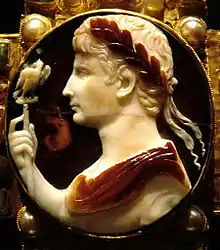بلاكاس قميو
بلاكاس قميو هو قميو روماني قديم كبير بشكل غير عادي، بطول يبلغ 12.8 سنتيمتر (5.0 بوصة)، منحوتة من قطعة من الجزع بأربع طبقات متناوبة من الأبيض والبني.[1] تُظهر رأسًا للإمبراطور الروماني أغسطس، وربما يعود إلى فترة قصيرة بعد وفاته في عام 14 ميلاديًا، وربما من 20 إلى 50 ميلاديًا.[2] ظلت القطعة في المتحف البريطاني منذ عام 1867، عندما حصل المتحف على مجموعة من الآثار الشهيرة التي ورثها لويس، دوق القميو عن والده، بما في ذلك كنز أسكلين.[3] وعادة ما يتم عرضها في الغرفة 70.[4]

بلاكاس قميو
معرض صور
المراجع
- Williams, 296. Most sources, including the current BM web-pages, say three layers, but the white re-emerges again above the brown on the aegis
- Williams, 296. The current BM web-pages prefer 14-20 AD.
- Highlights; Williams, 296, 345
- BM online catalogue
المصادر
- "BM online catalogue" "The Blacas Cameo"
- Boardman, John ed., The Oxford History of Classical Art, 1993, OUP,
- "Highlights": British Museum Highlights page "Cameo Portrait of Augustus", or the Blacas Cameo
- Henig, Martin (ed), A Handbook of Roman Art, Phaidon, 1983,
- Smith, R.R.R., "The Public Image of Licinius I: Portrait Sculpture and Imperial Ideology in the Early Fourth Century", The Journal of Roman Studies, Vol. 87, (1997), pp. 170–202, JSTOR
- Strong, Donald, et al., Roman Art, 1995 (2nd edn.), Yale University Press (Penguin/Yale History of Art),
- Vermeule, Cornelius, "Greek and Roman Gems" in Boston Museum Bulletin, Vol. 64, No. 335 (1966), pp. 18–35, Museum of Fine Arts, Boston, JSTOR
- Walker, Susan, and Burnett, Andrew, The Image of Augustus, 1981, British Museum Publications,
- Williams, Dyfri. Masterpieces of Classical Art, 2009, British Museum Press,
بلاكاس قميو في المشاريع الشقيقة
 صور وملفات صوتية من كومنز
صور وملفات صوتية من كومنز
- بوابة روما القديمة
This article is issued from Wikipedia. The text is licensed under Creative Commons - Attribution - Sharealike. Additional terms may apply for the media files.




